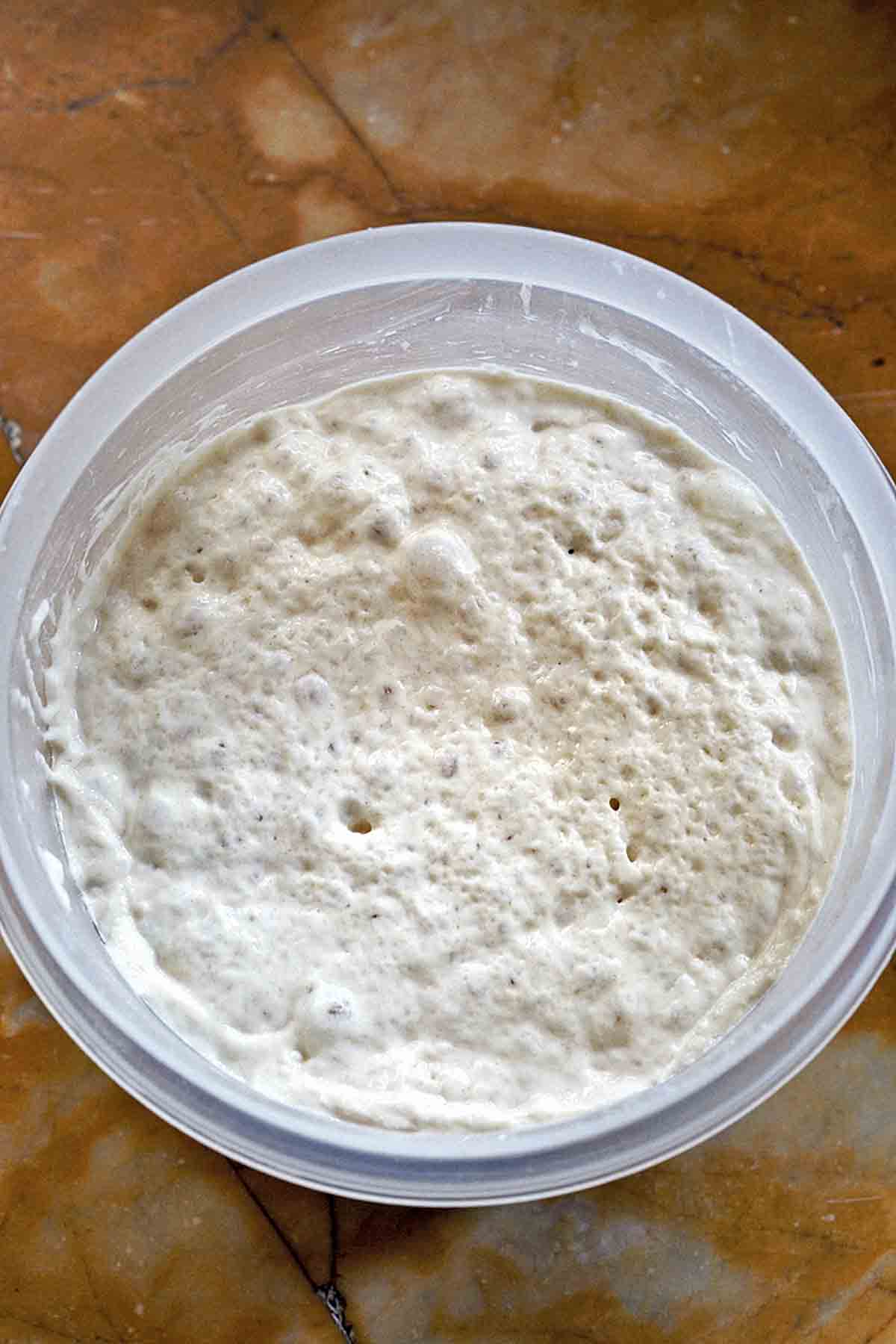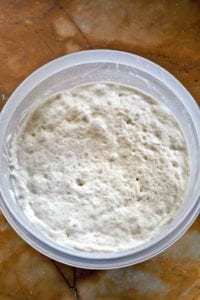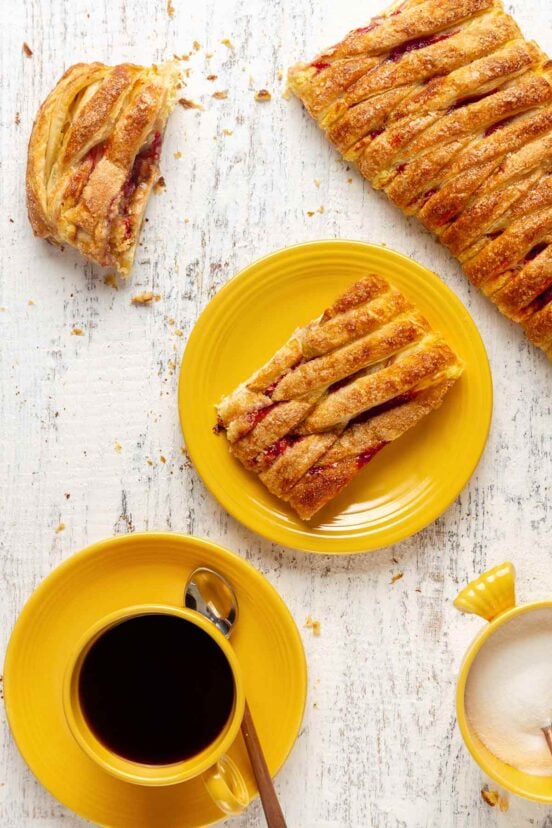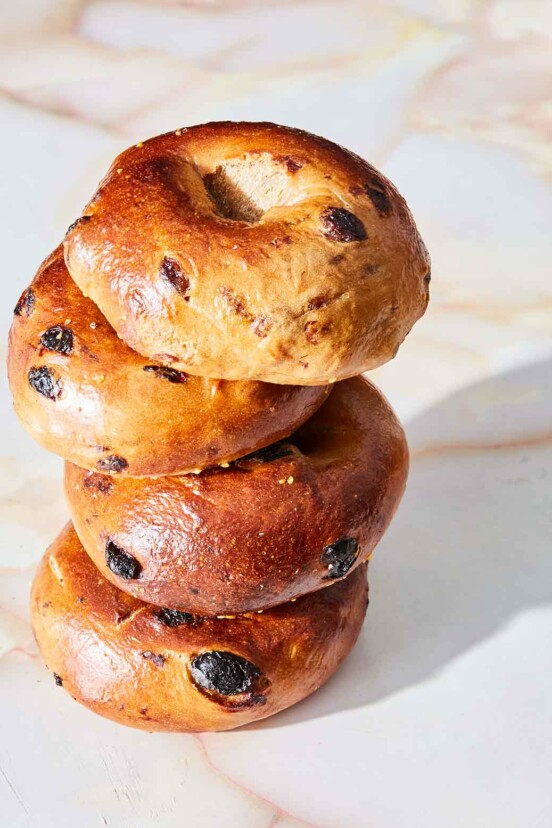
Many of the recipes for classic regional breads, such as this ciabatta recipe, begin with a starter dough made from small amounts of flour, water, and yeast allowed an initial fermentation. The starter, known as biga in Italy, or bighino when in small amounts, not only gives strength to what in Italy are weak flours, it also produces a secondary fermentation from which come the wonderful aroma, natural flavor, and special porosity of the final loaves and wheels of bread.
The important point about a biga is that the breads made with it develop a wonderful taste because their risings are long and bring out the flavor of the grain. Another benefit is that the loaves remain fresher and taste sweeter than those made with large amounts of commercial yeast.
In Italy, bakers use dough from the previous day’s baking to start a new dough. I keep some starter on hand at all times; by having it around, I can decide to make pane pugliese or ciabatta in the morning and have it for dinner that night. Because the first biga must come from somewhere, though, you may make it following the instructions below. It’s remarkable. It freezes very well and needs only about 3 hours at room temperature until it is bubbly and active again, or it can be refrigerated for up to 5 days.–Carol Field
LC Obliged to Biga Note
Behind each and every memorable bite of proper Italian bread we’ve daintily nibbled, hungrily inhaled, or otherwise somehow consumed, we have a biga to thank. So we’re feeling much obliged to Carol Field for this recipe. Nonna not included.

Italian Biga
Ingredients
- 1/4 teaspoon active dry yeast
- 1/4 cup warm water
- 3/4 cup plus 4 teaspoons water, preferably bottled spring water, at room temperature
- 2 1/3 cups unbleached all-purpose flour
- Vegetable oil, for the bowl
Instructions
- Stir the yeast into the 1/4 cup warm water and let stand until creamy, about 10 minutes.
- Stir the spring water into the creamy yeast mixture, and then stir in the flour, 1 cup at a time. If mixing by hand, stir with a wooden spoon for 3 to 4 minutes. If mixing with a stand mixer, beat with the paddle at the lowest speed for 2 minutes. If mixing with a food processor, mix just until a sticky dough forms.
- Transfer the biga to a lightly oiled bowl, cover with plastic wrap, and let rise at cool room temperature for 6 to 24 hours, until the starter is triple its original volume but is still wet and sticky. (The bakers I admire most advise 10 to 11 hours for the first rise, but others are very happy with the 24 hours it takes for dough to truly become yesterday’s dough, and if you like sour bread, allow your biga to rest for 24 to 48 hours or even 72 hours.)
- Cover and refrigerate or freeze the biga until ready to use. (If refrigerating the biga, use within 5 days. If freezing the biga, let it rest at room temperature for about 3 hours until it is bubbly and active again.) When needed, scoop out the desired amount of biga for your recipe and proceed. I strongly recommend weighing the biga rather than measuring it by volume since it expands at room temperature. If measuring by volume, measure chilled biga; if measuring by weight, the biga may be chilled or at room temperature.

Nutrition
Nutrition information is automatically calculated, so should only be used as an approximation.
Recipe Testers’ Reviews
This is a perfectly suitable starting point for most any bread which uses a starter. I bake bread several times a week and it’s nice to have this handy. Sometimes I add this to a bread dough which doesn’t call for a starter just for the added flavor.















For those who only want 500 grams of biga to use in their ciabatta recipe, I did some math!
51mL warm water
169mL regular water
280g all-purpose flour
500
Thanks, Mimi!
What if the recipe calls volume for unit of measuring the biga, let’s say 2 cups of biga are required, is there a way how we convert the biga weigh into volume measurement?
Cris, the recipe will make 2 1/3 cups of biga. If you want a specific amount, you can reduce the ingredients by the same percentage it takes you to get to that volume. Ie. to reduce from 2 1/3 cups to 2 cups, you would need to reduce each ingredient by about 15%.
Hello! I would like to make this biga and the ciabatta and eventually try biga in my own breads. But how is this flour measured? Dip and sweep or fluff and spoon? Or better yet, after all this time, have you guys come to a weight of flour that you use? I imagine that the quantity of flour and thus the hydration of the biga can make a big difference in the final flavors. I would really appreciate this pointer. Thank you so much!
Great question, Maya. We recommend you weigh your ingredients, particularly the flour. Above the ingredient list there is a US/Metric toggle switch, and if you toggle to metric, you’ll see the weights listed beside the ingredients.
Hi. When you say room temperature, what temperature range do you refer to? I live in a tropical climate, it’s always warm here.
Kim, there’s no specific temperature, but in a warm climate you’ll find that your biga is ready much closer to the 6 hour mark as opposed to taking 24 hours.